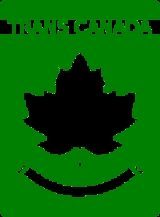
Trans-Canada Highway
Overview
Canadian French
Canadian French is an umbrella term referring to the varieties of French spoken in Canada. French is the mother tongue of nearly seven million Canadians, a figure constituting roughly 22% of the national population. At the federal level it has co-official status alongside English...
: Route Transcanadienne) is a federal-provincial highway
Highway
A highway is any public road. In American English, the term is common and almost always designates major roads. In British English, the term designates any road open to the public. Any interconnected set of highways can be variously referred to as a "highway system", a "highway network", or a...
system that joins the ten provinces of Canada
Canada
Canada is a North American country consisting of ten provinces and three territories. Located in the northern part of the continent, it extends from the Atlantic Ocean in the east to the Pacific Ocean in the west, and northward into the Arctic Ocean...
. It is, along with the Trans-Siberian Highway
Trans-Siberian Highway
The Trans-Siberian Highway is the unofficial name for a network of federal highways that span the width of Russia from the Baltic Sea of the Atlantic Ocean to the Japan Sea of the Pacific Ocean. In the Asian Highway Network, the route is known as AH6. It stretches over from St. Petersburg to...
and Australia's Highway 1
Highway 1 (Australia)
Australia's Highway 1 is a network of highways that circumnavigate the Australian continent, joining all mainland state capitals. At a total length of approximately it is the longest national highway in the world, longer than the Trans-Siberian Highway and the Trans-Canada Highway...
, one of the world's longest national highways, with the main route spanning 8,030 km (4,990 mi). The system was approved by the Trans-Canada Highway Act of 1948, with construction commencing in 1950. The highway officially opened in 1962, and was completed in 1971.
Unanswered Questions

